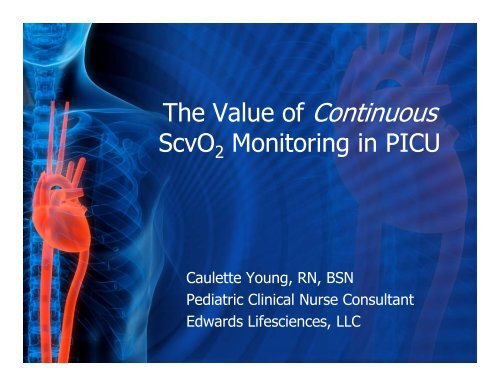Value of ScvO2 Monitoring in PICU - The Canadian Association of ...
Value of ScvO2 Monitoring in PICU - The Canadian Association of ...
Value of ScvO2 Monitoring in PICU - The Canadian Association of ...
Create successful ePaper yourself
Turn your PDF publications into a flip-book with our unique Google optimized e-Paper software.
<strong>The</strong> <strong>Value</strong> <strong>of</strong> Cont<strong>in</strong>uous<br />
ScvO 2 <strong>Monitor<strong>in</strong>g</strong> <strong>in</strong> <strong>PICU</strong><br />
Caulette Young, RN, BSN<br />
Pediatric Cl<strong>in</strong>ical Nurse Consultant<br />
Edwards Lifesciences, LLC
Disclaimers<br />
• Paid consultant for Edwards Lifesciences, LLC<br />
• Pediatric critical care products<br />
• Provide education, <strong>in</strong>-services, research &<br />
• Provide education, <strong>in</strong>-services, research &<br />
technical advice
Objective<br />
<strong>The</strong> goal <strong>in</strong> <strong>PICU</strong> is to ma<strong>in</strong>ta<strong>in</strong> a balance<br />
between oxygen delivery and consumption.<br />
Cont<strong>in</strong>uous ScvO 2 allows the cl<strong>in</strong>ician to<br />
2<br />
assess oxygen delivery and consumption <strong>in</strong><br />
real-time. Imbalances can rapidly be identified<br />
and treated earlier with improved outcomes.
What is our ma<strong>in</strong> goal for patients <strong>in</strong> ICU?<br />
• Adequate oxygenation & tissue<br />
perfusion<br />
How can we achieve this?<br />
• Ensure a balance between oxygen<br />
delivery & oxygen consumption<br />
How can we assess for this?<br />
• Cont<strong>in</strong>uous monitor<strong>in</strong>g ScvO 2
Reflection vs Transmission<br />
Spectrophotometry<br />
74<br />
LED photo detector<br />
Receiv<strong>in</strong>g fiber<br />
Transmission fiber<br />
SVC
Benefits <strong>of</strong> Cont<strong>in</strong>uous vs. Intermittent<br />
• Real-time, no wait<strong>in</strong>g for analysis results<br />
• Decrease risk for <strong>in</strong>fection<br />
• Decrease risk for transfusions<br />
• Early warn<strong>in</strong>g<br />
– Identification <strong>of</strong> DO 2/VO 2 imbalance<br />
– Traditional hemodynamic monitor<strong>in</strong>g unreliable<br />
• Cost sav<strong>in</strong>gs<br />
– F<strong>in</strong>ancial<br />
– Resources <strong>of</strong> staff<br />
– Prevention
Us<strong>in</strong>g cont<strong>in</strong>uous ScvO 2 monitor<strong>in</strong>g<br />
to evaluate tissue oxygenation at<br />
the bedside enables the cl<strong>in</strong>ician to<br />
detect early alterations <strong>in</strong> oxygen<br />
balance.<br />
(Goodrich 2006 Crit Care Nurs Cl<strong>in</strong> N Am)
“Oxygen delivery does not provide<br />
<strong>in</strong>formation about the adequacy <strong>of</strong><br />
tissue oxygenation.”<br />
Curley & Harmon<br />
Critical Care Nurs<strong>in</strong>g <strong>of</strong> Infants and Children 2 nd Ed
Uncorrected imbalances<br />
• Shift <strong>in</strong> dissociation curve: left or right<br />
• Hypoxia / hypoxemia<br />
• Acidosis<br />
• Redistribution or maldistribution <strong>of</strong> blood<br />
• MODS<br />
• Pulmonary hypertension<br />
• Cardiovascular collapse / cardiac arrest<br />
• Necrosis & irreversible cell death<br />
• Death
SVC-RA<br />
junction<br />
What is<br />
ScvO 2?<br />
Central venous oxygen saturation<br />
measured at the SVC-RA junction<br />
Indicative <strong>of</strong> balance between<br />
oxygen delivery & consumption<br />
Trends well with SvO 2<br />
Can be used as a surrogate for<br />
adequate cardiac <strong>in</strong>dex<br />
Early warn<strong>in</strong>g <strong>in</strong>dicator<br />
Used to guide therapy <strong>in</strong> sepsis &<br />
congenital cardiac surgery
ScvO 2<br />
Oxygen Delivery Oxygen Consumption<br />
Hemoglob<strong>in</strong> Cardiac<br />
output<br />
Heart<br />
rate<br />
Stroke<br />
volume<br />
Oxygenation<br />
/ventilation<br />
FiO 2<br />
Preload Afterload Contractility<br />
Metabolic demands
SvO 2 or ScvO 2: What’s the difference?<br />
• PA catheter or central l<strong>in</strong>e<br />
• Global or regional<br />
– SvO 2 represents mixed venous blood from:<br />
• SVC ≅ 70%<br />
• CS ≅ 37%<br />
• IVC ≅ 80%<br />
– <strong>ScvO2</strong> represents blood return<strong>in</strong>g from upper or<br />
lower body (depend<strong>in</strong>g on site)<br />
• Normal values:<br />
– SvO 2 (60-80%)<br />
– ScvO 2 (70-75%)<br />
• ScvO 2 usually runs ~7% higher than SvO 2<br />
• Difference can widen <strong>in</strong> shock states when<br />
perfusion redistribution occurs
Regional oxygen saturation from upper body<br />
Trends with SvO SvO2 values, nearly <strong>in</strong>terchangeable<br />
Re<strong>in</strong>hart et al Intensive Care Med. 2004<br />
ScvO 2 ……<br />
SvO 2<br />
ScvO 2 ……<br />
SvO 2
Has been considered a surrogate for cardiac<br />
output / <strong>in</strong>dex <strong>in</strong> pediatrics<br />
Tibby et al Arch Dis Child 2003
“Adequate” oxygenation can only be def<strong>in</strong>ed when<br />
tissue O 2 supply matches tissue O 2 demand<br />
Usually consumption (VO 2) <strong>in</strong>dependent <strong>of</strong> delivery (DO 2)<br />
DO 2I= CO x SaO 2 x Hgb x 1.34 x 10 = 650 + 50 ml/m<strong>in</strong>/m 2<br />
VO 2I= CO x (SaO 2-SvO 2) x Hgb x 1.34 x 10 = 120-200 ml/m<strong>in</strong>/m 2<br />
If VO 2 <strong>in</strong>creases or DO 2 decreases, tissue oxygenation is<br />
ma<strong>in</strong>ta<strong>in</strong>ed by <strong>in</strong>creas<strong>in</strong>g oxygen extraction<br />
O 2ER = VO 2/DO 2 x 100 = 25 + 2%<br />
If DO 2 drops below a critical level, oxygen extraction<br />
becomes exhausted result<strong>in</strong>g <strong>in</strong> VO 2 dependent on DO 2 or<br />
oxygen debt<br />
Tissue hypoxia occurs!<br />
Note: O 2ER <strong>in</strong>creases well before lactate beg<strong>in</strong>s to accumulate
ScvO 2 / SvO 2<br />
70-75%<br />
< 70% and > 50%<br />
< 50% and > 30%<br />
Physiology<br />
Normal extraction<br />
(non-cyanotic cardiac)<br />
Compensatory extraction<br />
( demand or supply)<br />
Limits <strong>of</strong> extraction<br />
(beg<strong>in</strong>n<strong>in</strong>g <strong>of</strong> lactic<br />
acidosis)<br />
< 30% and > 25% Severe lactic acidosis<br />
< 25% Cellular death<br />
Bloos & Re<strong>in</strong>hart; Intensive Care Med (2005) 31:911–913
Factors to be considered <strong>in</strong> Oxygenation<br />
Alveolar-pulmonary capillary O 2 transport<br />
• Gas exchange <strong>in</strong> term<strong>in</strong>al portion <strong>of</strong> lungs<br />
O2 transport <strong>in</strong> the blood<br />
• Hemoglob<strong>in</strong> & oxyhemoglob<strong>in</strong><br />
− Arterial O2 content (CaO2) − Oxyhemoglob<strong>in</strong> dissociation curve<br />
− O2 delivery (DO2) Cellular respiration<br />
• Oxygen consumption<br />
• Oxygen extraction ratio (O 2ER)<br />
− Tissue oxygenation dependent on<br />
microcirculation<br />
− Microcirculation adjusts to enhance O 2<br />
extraction<br />
DO 2<br />
VO 2
VO 2<br />
Once O 2 extraction<br />
has been maximized,<br />
VO 2 becomes<br />
dependent on DO 2<br />
Critical O 2<br />
DO 2<br />
Tissues extract<br />
what’s needed. If<br />
DO 2 decreases or<br />
VO 2 <strong>in</strong>creases,<br />
O 2ER <strong>in</strong>creases<br />
to meet demands<br />
Pathologic<br />
Tissue hypoxia<br />
occurs when VO 2<br />
exceeds DO 2
Normal<br />
O O2 ER<br />
DO 2<br />
O 2ER may <strong>in</strong>crease to<br />
meet O 2 demands, when<br />
DO 2 is decreased or<br />
VO 2 is <strong>in</strong>creased.<br />
Normal O 2ER 25-30%<br />
Pathologic
VO VO2 O 2 debt: Why is it important?<br />
It needs to be paid back with <strong>in</strong>terest<br />
O 2 debt<br />
Time<br />
Interest<br />
DO 2 needs to meet current<br />
O 2 needs and satisfy the<br />
needs that were previously<br />
unmet
Oxygen Saturation <strong>Value</strong>s<br />
Site Acyanotic Cyanotic<br />
Superior vena cava 70-75% 35-55%<br />
Right atrium / ventricle 75% 67% / 80%<br />
Pulmonary ve<strong>in</strong> 95% 88%<br />
Aorta 95% 80%<br />
Left atrium / ventricle 95% 90%<br />
Inferior vena cava 78%
Pulmonary Hypertension <strong>in</strong> Post-op Cardiac<br />
Critical Heart Disease <strong>in</strong> Infants & Children 2 nd Ed<br />
Stimulant: Pa<strong>in</strong>, agitation, hypoxia, hypothermia, suction<strong>in</strong>g,<br />
acidosis, hypercarbia<br />
PVR R L shunt<br />
Q p Q s<br />
ScvO 2 /SvO 2<br />
Hypoxic vasoconstriction<br />
PaO 2<br />
PaCO 2<br />
DO 2<br />
Cardiac arrest
When is Change Significant?<br />
• Change from basel<strong>in</strong>e ≥ 5-10%<br />
susta<strong>in</strong>ed > 5 m<strong>in</strong>utes<br />
• <strong>Value</strong>s may fluctuate ± 5%, with<br />
activities or <strong>in</strong>terventions (i.e.<br />
suction<strong>in</strong>g)<br />
• Slow recovery may <strong>in</strong>dicate<br />
cardiopulmonary system’s <strong>in</strong>ability to<br />
respond to <strong>in</strong>creases <strong>in</strong> O 2 demand
Causative Factors<br />
(Decreased O 2delivery)<br />
↓Cardiac Output (CO)<br />
ScvO 2 < 70%<br />
↓O 2 Saturation (SaO 2)<br />
↓ Hgb concentration<br />
Cl<strong>in</strong>ical Conditions<br />
Left ventricular dysfunction<br />
Shock<br />
Hypovolemia<br />
Hypoxemia<br />
Lung Disease<br />
Respiratory failure<br />
Anemia<br />
Hemorrhage<br />
Hemodilution<br />
Dyshemoglob<strong>in</strong>emias
Causative Factors<br />
Increased O 2 consumption<br />
ScvO 2 < 70%<br />
Cl<strong>in</strong>ical Conditions<br />
Traumatic bra<strong>in</strong> <strong>in</strong>jury (138%)<br />
Burns (100%)<br />
Sepsis (50-100%)<br />
Shiver<strong>in</strong>g (50-100%)<br />
MODS (20-80%)<br />
Increased WOB (40%)<br />
Position change (31%)<br />
Suction<strong>in</strong>g (27%)<br />
Bath (23%)<br />
Dress<strong>in</strong>g change (10%)<br />
Fever each °C (10%)
Causative Factors<br />
Increased O 2 delivery<br />
(DO 2)<br />
ScvO 2 > 70%<br />
Decreased O 2 consumption<br />
(VO 2)<br />
Cl<strong>in</strong>ical Conditions<br />
PaO 2<br />
Hemoglob<strong>in</strong><br />
Cardiac output<br />
Anesthesia<br />
Hypothermia<br />
Dyshemoglob<strong>in</strong>emias<br />
Venous hyperoxia
Understand<strong>in</strong>g the cl<strong>in</strong>ical significance <strong>of</strong><br />
SvO 2 (ScvO 2) measurements….can help<br />
guide cl<strong>in</strong>ical decision-mak<strong>in</strong>g to assure<br />
adequate oxygenation to meet tissue<br />
needs.<br />
(Sanders, 1997 Applied Pathophysiology)
“Useful <strong>in</strong><br />
patient types”<br />
• Congenital cardiac surgery<br />
• Pediatric sepsis<br />
• High risk surgery<br />
• Respiratory failure<br />
• Trauma<br />
• Burns<br />
• Jugular bulb<br />
“Useful <strong>in</strong> patient<br />
management”<br />
• Fluid adm<strong>in</strong>istration &<br />
boluses<br />
• Vasoactive <strong>in</strong>fusions<br />
• Blood transfusions<br />
• Ventilatory management<br />
• Arrest resuscitation<br />
• End-organ perfusion
Thank You!<br />
“Hypoxia not only stops the mach<strong>in</strong>e, it wrecks<br />
the mach<strong>in</strong>ery”<br />
John Scott Haldane, 1880<br />
Caulette_young@edwards.com<br />
www.Edwards.com/pediasat




